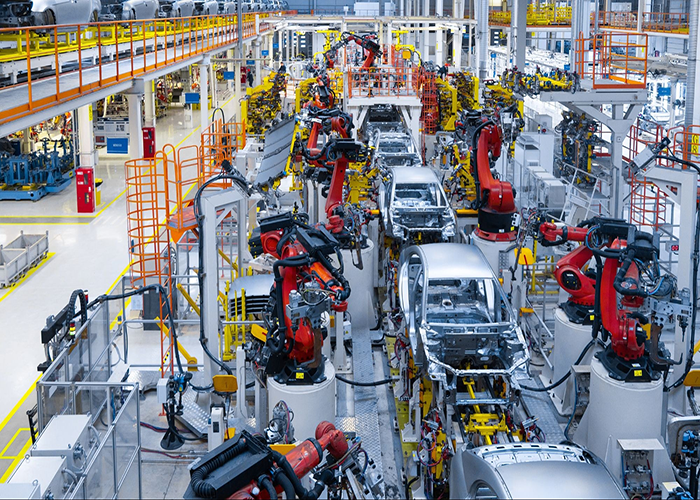Water and Wastewater Management Solutions for Automobile Industries Using ETP, STP, WTP, RO, WWTP, and Reuse Technologies

India's automobile industry is one of the largest in the world, producing millions of vehicles annually. From passenger cars to commercial and two-wheelers, this sector is a major contributor to GDP and employment. It also drives ancillary industries like steel, rubber, electronics, and paint.
Maharashtra stands as a central hub for automotive manufacturing, with major facilities in Pune, Nashik, and Aurangabad. Numerous domestic and international players operate here, supported by a well-developed infrastructure and skilled workforce. However, such a scale also demands responsible water use and wastewater treatment.
Water is used in cooling, painting, surface treatment, washing, and manufacturing across units.
Water is indispensable in the automobile industry. It is used for surface treatment, cooling systems, electroplating, painting booths, and component washing. Cleaning of floors, equipment, and finished vehicles also consumes significant water.
Most manufacturing units also require treated water for boilers and HVAC systems. Moreover, paint shops and pre-treatment processes are among the most water-intensive areas. With such extensive usage, industries must ensure water conservation and treatment for sustainable operations.
Surface treatment, painting, washing, and cooling generate significant quantities of wastewater.
Several operations in automobile manufacturing produce contaminated wastewater. Painting sections release chemical-laden rinse water, while electroplating and metal finishing create water with heavy metals. Vehicle washing generates oil-rich wastewater and suspended solids.
"Water is more than a utility in automobile manufacturing—it’s a vital resource that fuels every operation. Efficient management, recycling, and treatment of water not only ensure smooth production but also reflect an industry’s commitment to environmental stewardship and responsible growth in today’s competitive global market."
Even cooling towers and process lines discharge water with high temperatures and dissolved solids. If untreated, this wastewater poses risks to the environment. Therefore, identifying these sources and installing the right treatment systems is critical for compliance and sustainability.
Wastewater types include oily waste, paint residue, chemical effluent, and heavy metal contamination.
The nature of wastewater in the automobile industry varies with the processes. Pre-treatment and painting lines generate water with phosphates, chromates, and solvents. Electroplating areas contain heavy metals like nickel, chromium, and zinc.
Washing areas produce oily wastewater and sludge, while cooling systems may discharge water with biocides and antiscalants. All these effluents require segregation and specialized treatment before they can be discharged or reused safely within the plant.
Multistage treatment, including oil separation, chemical dosing, filtration, and biological systems, is used.
Automobile industries deploy comprehensive wastewater treatment systems. First, oil separators remove floating hydrocarbons from wash water. Neutralization tanks balance pH, followed by chemical dosing to precipitate heavy metals and dissolved contaminants.
Sedimentation tanks and pressure sand filters remove suspended solids, while advanced stages like Activated Sludge Process (ASP) or Membrane Bioreactors (MBR) treat organic matter. Treated water can either be discharged within norms or further processed for reuse in non-critical operations.
RO, UF, MBR, and automation enable water reuse and zero liquid discharge goals.
To reduce freshwater dependency, many automobile manufacturers adopt advanced technologies like Reverse Osmosis (RO) and Ultrafiltration (UF) systems. These systems treat wastewater to high purity levels, allowing it to be reused in washing, cooling, or even painting operations.
Membrane Bioreactor (MBR) systems ensure compact treatment with superior output quality. Automated control panels and IoT monitoring tools help optimize performance and reduce operational costs, making water treatment more innovative and more efficient.
Tailor-made ETP, STP, and RO systems to meet industry-specific water treatment needs
We provide end-to-end water and wastewater treatment solutions specifically designed for automobile industries. From bare Effluent Treatment Plants (ETP) to advanced Zero Liquid Discharge (ZLD) systems, our solutions ensure regulatory compliance and efficient water management.
Our services include site assessment, design, supply, installation, automation, and after-sales maintenance. We customize systems to meet the unique challenges of surface treatment, paint shops, and oily wastewater. With a focus on quality and innovation, we help industries reduce their water footprint and enhance sustainability.
Conclusion: Water Treatment Is Key to Sustainable Automotive Manufacturing

Conclusion: Water Treatment Is Key to Sustainable Automotive Manufacturing
The automobile sector's growth depends on its ability to manage resources wisely. Water, being essential to almost every production step, must be treated and reused efficiently to reduce costs and environmental impact.
With the integration of proper treatment systems like ETP, STP, and RO, automobile industries can achieve sustainable operations and meet environmental guidelines. Our tailored solutions support these industries in attaining long-term water efficiency and zero liquid discharge objectives.

